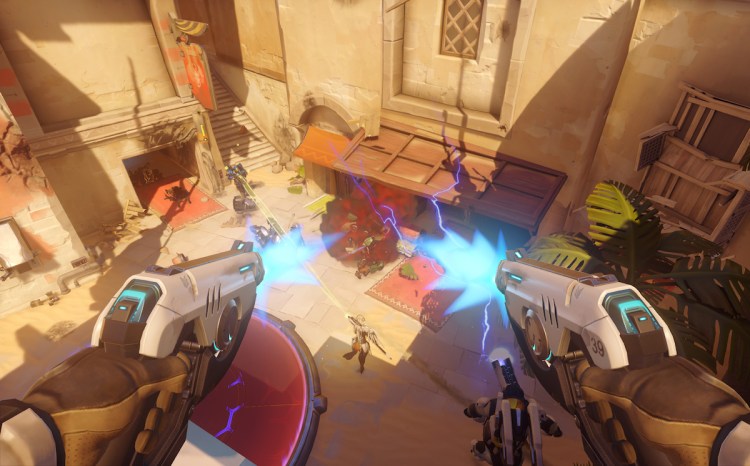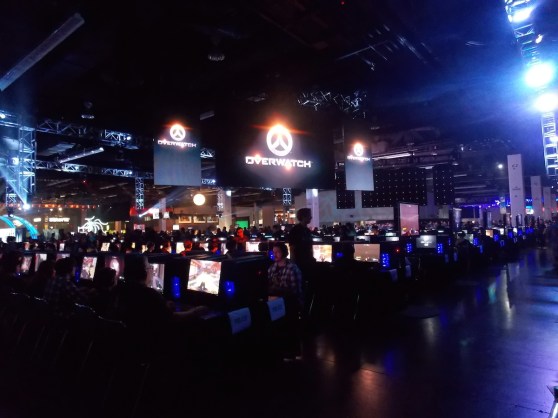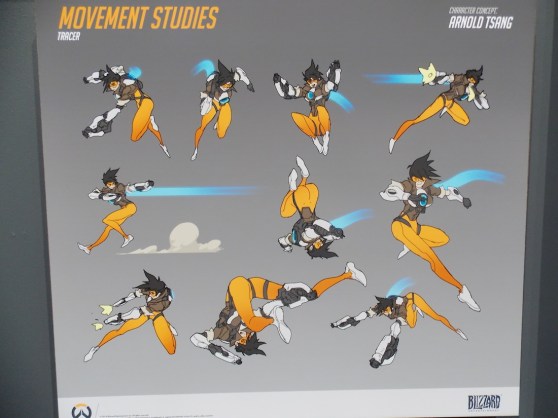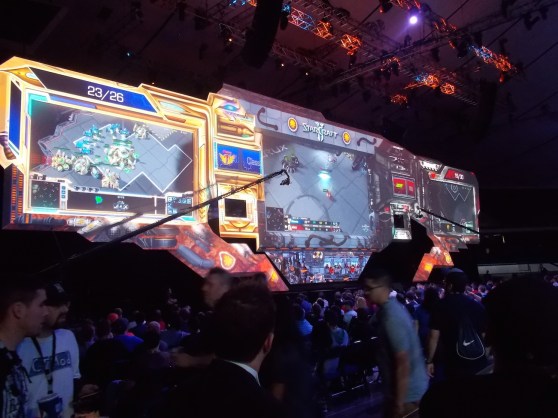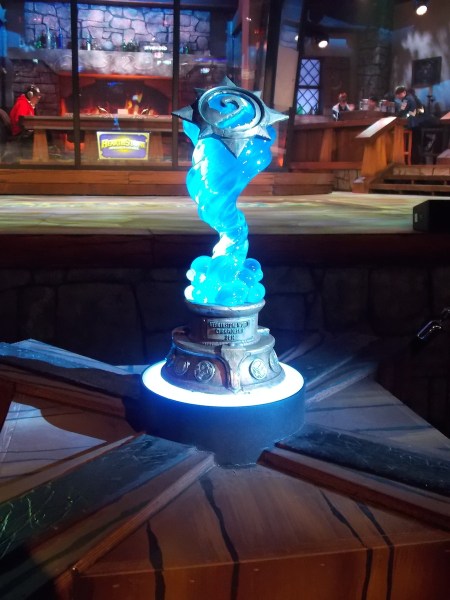On Friday morning, Nov. 7, Chris Metzen was standing in front of thousands of people on BlizzCon’s gigantic main stage. He looked like he was on the verge of tears. His voice was wavering. The hand holding his mic was shaking. And people in the audience started drumming their legs in anticipation.
The senior vice president of story and franchise development was building up to a historic moment at Blizzard Entertainment’s annual fan convention. He was about to announce the studio’s first new game in 17 years that isn’t related to its three popular franchises (Warcraft, StarCraft, and Diablo). Overwatch, a stylized team-based multiplayer shooter for the PC, made its debut with a short animated film, winning the crowd with its intriguing premise of dueling superpowered agents and a triumphant musical score.
Metzen’s nervousness wasn’t just tied to a new game announcement. Overwatch is just the latest result of a years-long change going on within Blizzard. The company is no longer relying on just triple-A blockbuster products that retailers can stock on their shelves. Hearthstone: Heroes of Warcraft and Heroes of the Storm have led the charge for smaller, digital-only releases. They’re part of genres (collectible-card game and mobile online battle arena, or MOBA, respectively) and business models (both are free-to-play while Overwatch is still undetermined as of this writing) that are brand new for Blizzard.
Together with World of Warcraft, Diablo III, and StarCraft II, this is perhaps the most diverse lineup of games the developer has ever had in its 23-year history. The energy and enthusiasm that surrounded them was palpable at this year’s show, where I saw a confidence and swagger that wasn’t present at BlizzCon 2013. According to the people who make those games, it’s exciting to watch Blizzard undergo this transition. While they say they never lost their passion for game development, it’s also never been this open and transparent for the world to see.
‘We didn’t go anywhere, but we’re back’
A few hours after the announcement, Metzen and Overwatch game director Jeff Kaplan were sitting in front of a substantially smaller audience at a press conference. Metzen sounded noticeably more relaxed, if a little exhausted. He spoke about how important working on Overwatch and other recent games have been for the company.
“What you see happening in the last couple years with Hearthstone, Heroes, Overwatch — we can talk about Overwatch! Holy shit! Sorry. I feel like … I almost said this at the opening [ceremony]: We didn’t go anywhere, but we’re back,” said Metzen. “I feel like this studio’s sense of raw energy and creativity and focus and appreciation for maybe even smaller scale projects has been rekindled. It has no bearing at all on the fact that World of Warcraft is our most precious, precious product. We have obviously a really great team driving that business.
“But you start to see this spark now — smaller points of engagement — that are totally driven by passion, totally driven by people geeking out of their minds. You can feel it around the studio. It’s wonderful. Right after 20-something years, it’s the coolest time to be at this place.”
That wasn’t something I expected to hear from the people who made the incredibly popular World of Warcraft, which is still a vital part of Blizzard’s (and parent company Activision’s) business. The massively multiplayer online role-playing game is turning 10 years old this month, and its fifth expansion, Warlords of Draenor, came out on Nov. 13. But operating such a large game for so long overshadowed what Metzen calls their creative “spark.” Blizzard was in danger of becoming “the World of Warcraft company.”
Solving a Titan-sized problem
That line of thinking eventually led the company to begin work on Titan, the codename for their successor to WOW. Unfortunately, development didn’t go smoothly. In spring 2013, Blizzard scrapped its original plans and started over from the beginning. And just a few months before this year’s convention, Blizzard told video game site Polygon that it actually canceled the game after it couldn’t find a way to make its ambitious ideas work.
The topic of Titan was unavoidable at the show. Several reporters at the press conference asked if Overwatch had any connection at all to the failed MMO. Kaplan gave a diplomatic answer, saying they borrow ideas from past Blizzard games all the time and Overwatch has just as much of Titan in it as it does of WOW. While Metzen didn’t want to get into their original vision for Titan, he did touch on the challenges they experienced in trying to turn it into a reality.
“I can tell you what it was: It was frustrating,” he said. “It was a big, giant idea. It was almost like six video games in one. … And we wrestled with it for a long time. And it sucked. We couldn’t figure it out.”
The idea for Overwatch brought them out of that funk. Kaplan described how it took over the studio in a “grassroots” way, drawing attention and excitement from folks who were working on other projects. When they decided to go all-in on it, Metzen says “the music just exploded.
“We started looking at this game for what it was, and it just unleashed this tidal wave of passion and certainty and distilled, clear ideas. … It was just this monstrous thing of energy,” he said. “It’s been the funnest year getting our feet back under us, getting our surety back.”
Listening to them talk about their comeback story (and the fact that they even needed one at all) was fascinating — how often do you hear a developer as big as Blizzard admit its faults out in the open like that? It affected my perception of the rest of the show. I couldn’t help but see the higher production values at BlizzCon 2014 as Blizzard’s way of sharing that newfound energy with 25,000 of its biggest fans.
A bigger, bolder BlizzCon
If for some reason you only had time to check out one thing at BlizzCon, it had to be the StarCraft II tournament stage. The animations and scenery projected on the giant screen made it feel alive. It had a bunch of different backdrops, and the borders changed depending on which race players chose (the Zerg, for example, had pulsating tentacles and purple goo surrounding the player’s screen). When a match was over, the stage would change again to reflect the winner’s side.
Chris Sigaty couldn’t believe how well it turned out. Though he didn’t have a hand in building it, the executive producer of StarCraft II and Heroes of the Storm says he would love to “unleash” his artists on it for future shows. Sigaty has been with Blizzard since its early years. He started out as a tester for Beyond the Dark Portal, an expansion for the real-time strategy game Warcraft II: Tides of Darkness.
He’s less than two years away from earning his helmet, which is given to employees who’ve been with the company for 20 years (they get a sword at five years, a shield at 10, and a ring at 15).
“Yeah, we’ve changed. … We’ve changed how we talk, how we listen, how we interact,” said Sigaty. “Internally, we’re doing a lot. Even how teams are individually just reaching out to communities: ‘What do you think? Come check out what we have.’ We’re trying to have a much more open-arm approach. There’s some level of perception out there that I see when I read that Blizzard has traditionally been more behind a wall. I don’t think that was ever an intentional thing. … That’s not who we are.
“There are a lot of passionate individuals who’ve been here for a long time, and a lot of great new talent all coming together. There are people running relatively small teams doing really cool stuff. I’m super excited to be a part of it. I think the spark has always been there, but it’s much more visible now.”
StarCraft II wasn’t the only game that had an amazing stage. For the Hearthstone World Championship, Blizzard built half of a tavern inside of the Anaheim Convention Center. The level of detail was astounding. It had the kind of attention and care you’d normally find at a Disneyland ride.
Players sat at opposite ends of a long dinner table while a digital fire flickered next to them. Stacks of casks hung near the walls. The staircases leading backstage even had framed pictures of art from actual Hearthstone cards.
It looked almost too pretty to break down. But Hearthstone senior producer Yong Woo assured me that it’ll live on in some form at future tournaments. He says they’ve been “fighting tooth and nail” to bring pieces of that stage back to their Irvine, Calif. headquarters.
Woo joined Blizzard five years ago, where he helped out on other games before becoming a part of the Hearthstone team. He thinks the company is in the middle of a “transformative” time.
“What does it mean if we don’t sell boxed products? What does it mean if we do online-only distribution? It’s been really exciting,” said Woo. “I go to work every day, and it just really feels like we’re innovating, we’re growing, we’re learning. And Hearthstone — every day is about learning. We’re doing things we’ve never done before. We get this data about new experiments we’re trying: ‘How is that venture doing? How’s it being received? How is the expansion being received?’ It’s been a super positive and amazing experience.”
Although Hearthstone only came out of beta earlier this year, it already has 20 million players across PC, Mac, and iPad (support for Android tablets is coming in December). Blizzard released a single-player update, the Curse of Naxxramas, this past summer, and it’s getting ready to introduce 120 new cards in the upcoming Goblins vs. Gnomes expansion.
“It’s never stagnant. That’s kind of the best part: We’re always evolving,” Hearthstone software engineer Rachelle Davis added. “We iterate over and over and over until … well, actually, always. We never stop. [Laughs]”
‘I don’t care if it cracks the world’
Between new expansions, multiple e-sports tournaments, details about the live-action Warcraft movie (see the gallery below for pics of the props), and interesting panels, it was impossible for me to see or play everything at BlizzCon 2014. It was so busy that WOW senior designer Brian Holinka felt like his team could just kick back and enjoy the show because they didn’t have much left to say before the Warlords of Draenor launch.
That WOW wasn’t the main draw of the show speaks volumes about how different this BlizzCon felt from last year’s. The explosion of energy that Metzen was talking about was evident in the developers’ words and reactions. After the crushing failure of Titan, they desperately needed to get back into a groove, and they found it by focusing on these smaller projects.
“Recognizing that our power comes from the simplest place — just the passion — that’s the thing we know,” said Metzen. “When we’re erring on the side of that, we’ll probably be OK. … For me, this is my opinion: I don’t care if [Overwatch] cracks the world in half with its economics. I don’t care at all. I just love it. And it’s so cool to get back to that place of just developing from that core passion.”
VentureBeat's mission is to be a digital town square for technical decision-makers to gain knowledge about transformative enterprise technology and transact. Learn More
